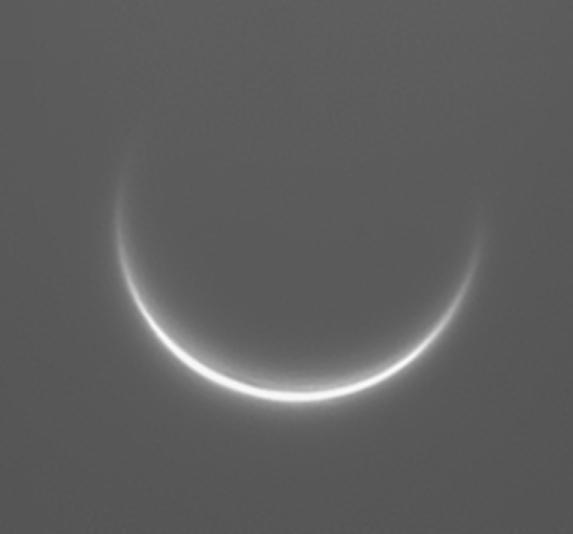Since late last spring Venus has been an evening star in our skies, shining brilliantly in the southwest. It was not the best of apparitions for those of us at mid-northern latitudes as it hung out in the basement of the zodiac when reaching its greatest distance from the Sun. I only managed a couple of casual observations and a single imaging attempt due to the planet often being obstructed by trees or buildings from my home observing venue.
Like all evening appearances of our sister planet, the transition from evening to morning star is defined by Venus reaching "inferior conjunction." This event, where the planet passes between Earth and the Sun, was set to occur on Saturday, January 8th around 7:40 p.m. our time. If the Earth-Venus-Sun orbital alignment were straight on we would witness Venus transiting the face of our home star at each one of these passages. But, just as we are not treated to a solar eclipse at every new Moon, Venus' orbital inclination of 3° to the ecliptic causes her to glide north or south of the Sun. Only roughly once a century do we get to witness a pair of transits, spaced eight years apart, with the most recent taking place in June of 2012.
This weekend's conjunction saw Venus skirting Sol's northern limb by about 4.5°, leading most websites such as In the Sky to state
At closest approach, Venus will appear at a separation of only 4°51' from the Sun, making it totally unobservable for several weeks while it is lost in the Sun's glare.
 |
| S&T Image Credit |
In actuality, to describe it as totally unobservable is perhaps a bit of an exaggeration. It's one of those observing challenges that can be done, albeit with great care since even a brief exposure to the Sun's surface through any sort of optical aid can easily damage your retina. I've viewed Venus in the daytime before, both naked eye and with telescope, on numerous occasions, but had never attempted an Inferior Conjunction sighting. With the forecast for conjunction day looking quite good I decided to take up this challenge.
My hope was to actually get an image of the event, so I arose before dawn to mount the 6" reflector and perform an alignment. After battling some passing clouds I finally got the Celestron mount able to slew to a target with reasonable accuracy. I left the drive running and waited for my quarry to rise high enough in the eastern sky to view it.
By 10:30 a.m. the winter Sun was well placed so I attached the camera and asked the mount to center Venus. I had placed a red filter in the optical path to help boost contrast against the bright blue sky, but the screen was still a bright, featureless canvas. I tried slowly sweeping the area a little bit to no avail. I finally removed the camera and substituted a 16mm eyepiece to see if I could make a visual sighting, but that, too, ended in failure. I reluctantly broke down the equipment and headed inside.
Not quite willing to accept defeat, while eating lunch I plotted my next attack. I considered that Venus should be positioned pretty much at the 12 o'clock position relative to the Sun's disk at this time. What if I positioned myself such that the apex of the neighbor's house blocked old Sol? Would that allow me catch Venus in the sky above the roofline with binoculars? I grabbed my trusty 7x50 Celestron binoculars and headed outside to find out. I swept the area until my arms grew tired with still no sign of the planet. As a last ditch effort I brought out the 15x70 Oberwerk binoculars to see if they might do the trick. After about five minutes - there!! A surprisingly bright, tiny crescent lying on its back was visible above the rooftop. It was a little surprising how clear one could distinguish the crescent shape and how white, like snow, the disk seemed in the blue sky.
I hurried inside to grab the Canon and telephoto lens in hopes of capturing a shot using the same technique. When I emerged and used the Oberwerks to try to relocate Venus I struggled. Where the heck was it - I had just seen the darn thing. Then fate lent a hand when a jet billowing a contrail behind it crossed the field. Within a few seconds I had identified Venus again. Once the contrail had dissipated, it was again tough to pick out the tiny crescent. A few minutes later another jet deposited its white contrail in the vicinity, and again it became easier to pick up Venus in the field. Thinking about this I suspect that as the field jostled from my unsteady hand the planet moved with the contrail, thus becoming more apparent to my brain. Whatever the actual reason it was an undisputed truth that having the contrail in the field made picking up the planet easier.
In yet another testimony to our eyes' logarithmic response to light, the photos appear to have been a bust as well since exposures long enough to possibly pick up Venus were overexposed. The result is in a field containing a wide range of light intensities, our eyes will provide a good image whereas it is often impossible for the camera to capture it. And although I may have come away with no photographic proof of my success, the experience adds another page in my book of amateur astronomy that I will have fond memories of.
 |
| A digital sketch of Venus & Contrail |
